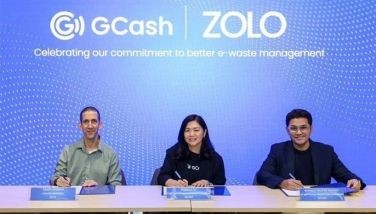Eyes bigger RP exposure, medium enterprises
June 22, 2004 | 12:00am
The Export-Import Bank of the United States (Ex-Im Bank) is still bullish about expanding its present financial exposure of $2.3-billion in the Philippines, and the medium-sized enterprises seem to be "the flavor of the month."
April H. Foley, Ex-Im Bank vice chairman and first vice president, tags the medium-sized enterprises as drivers of the Philippine economy.
However, Foley also decried that it is also one of the most "underserved" business sectors of Philippine society.
"One of the most exciting developments is the significant increase in recent applications from medium-sized enterprises ranging from $100,000 up to $1 million."
The biggest increase in the number of transactions came from that sector which is diverse, broad-based like sausage manufacturing equipment, purchase of forklift trucks for various retail transactions, seaweed processing equipment, restaurant equipment for restaurant school, and a pottery kiln.
"They are an important driver of the Philippine economy. When you get lots of medium-sized enterprises competing and growing, they become major drivers of jobs creation, also resulting in a healthy consuming middle class," the Ex-Im Bank vice chairman said.
The average loan amounts for medium enterprises ranges from $200,000 to $6-million. So far this year, they are involved in 30 transactions.
Foley said that it is an important sector of the business community that local banks have been hesitant to extend loans. While admitting that medium enterprises are relatively high risk in the eyes of the banking community, its significance in economic recovery weighs more heavily.
"This is a segment that is underserved by the local banking system. They find it difficult to get finances because of its high-risk nature."
However, the medium enterprises need their equipment if they are to contribute to the local and national economies, if they are to contribute to the employment sector.
Ex-Im Bank is prepared to take a look at their business and viability. After looking at their accounting statement and believe in their viability and competitive prospects, the US government financial institution is prepared to act as guarantor to their loan to another foreign or local financial institution.
"Thus they get their financing, their equipment or procure their supplies, and they get it at a reasonable cost than what is available in the local banking system when a local bank has the benefit of our guarantee which automatically lowers the risk of that transaction," Foley claims.
Ex-Im Bank views financial institutions especially banks as multipliers. It has limited resources for direct lending but it is confident on its ability to guarantee loans.
Local banks are not only the sources of direct funding but are able to inform the market of the presence of a guarantee from Ex-Im Bank.
Foley explained that if a medium enterprise for example is in need of a US-made equipment, local banks like China Banking Corp. (China Bank) or the Metropolitan Bank and Trust Corp. (Metrobank) can extend a loan with an Ex-Im Bank guarantee.
China Bank and Metrobank has an Ex-Im Bank master guarantee agreement that allows the two local banks to extend risk-free loans to endorsed enterprises. Some of the banks with similar accords are the Philippine National Bank (PNB), ABN AMRO and Deutsche Bank.
In fact, it is still in the market to sign similar agreements. "We have spoken to a few others already in recent days," the bank vice chairman revealed.
There is a one-time fee on loan charged through the lending bank. Ex-Im Bank then slaps a 1.25-percent interest rate while the participating or lending bank adds its "profit margin" for the total interest rate on the loan.
Previous financial involvements by Ex-Im Bank includes the Philippine Airlines (PAL), several independent power producers (IPPs), medical institutions and hospitals, the Transpacific Broadcast Group International, Information Technology Soutions International Inc., waste management and disposal equipment for semiconductor locators in Cabuyao, Laguna; Panay Oil Manufacturing Corp.; and, Akasya Mindanao Inc.
It is also exploring new opportunities in the power sector as the country needs huge amounts of capacities by 2008.
"It also has come to our attention that the Philippines is thinking about establishing itself as a center of medical tourism, and we would be in a position to support any equipment, design or hospital services that might be needed to enable the Phils to establish that kind of business," Foley added.
April H. Foley, Ex-Im Bank vice chairman and first vice president, tags the medium-sized enterprises as drivers of the Philippine economy.
However, Foley also decried that it is also one of the most "underserved" business sectors of Philippine society.
"One of the most exciting developments is the significant increase in recent applications from medium-sized enterprises ranging from $100,000 up to $1 million."
The biggest increase in the number of transactions came from that sector which is diverse, broad-based like sausage manufacturing equipment, purchase of forklift trucks for various retail transactions, seaweed processing equipment, restaurant equipment for restaurant school, and a pottery kiln.
"They are an important driver of the Philippine economy. When you get lots of medium-sized enterprises competing and growing, they become major drivers of jobs creation, also resulting in a healthy consuming middle class," the Ex-Im Bank vice chairman said.
The average loan amounts for medium enterprises ranges from $200,000 to $6-million. So far this year, they are involved in 30 transactions.
Foley said that it is an important sector of the business community that local banks have been hesitant to extend loans. While admitting that medium enterprises are relatively high risk in the eyes of the banking community, its significance in economic recovery weighs more heavily.
"This is a segment that is underserved by the local banking system. They find it difficult to get finances because of its high-risk nature."
However, the medium enterprises need their equipment if they are to contribute to the local and national economies, if they are to contribute to the employment sector.
Ex-Im Bank is prepared to take a look at their business and viability. After looking at their accounting statement and believe in their viability and competitive prospects, the US government financial institution is prepared to act as guarantor to their loan to another foreign or local financial institution.
"Thus they get their financing, their equipment or procure their supplies, and they get it at a reasonable cost than what is available in the local banking system when a local bank has the benefit of our guarantee which automatically lowers the risk of that transaction," Foley claims.
Ex-Im Bank views financial institutions especially banks as multipliers. It has limited resources for direct lending but it is confident on its ability to guarantee loans.
Local banks are not only the sources of direct funding but are able to inform the market of the presence of a guarantee from Ex-Im Bank.
Foley explained that if a medium enterprise for example is in need of a US-made equipment, local banks like China Banking Corp. (China Bank) or the Metropolitan Bank and Trust Corp. (Metrobank) can extend a loan with an Ex-Im Bank guarantee.
China Bank and Metrobank has an Ex-Im Bank master guarantee agreement that allows the two local banks to extend risk-free loans to endorsed enterprises. Some of the banks with similar accords are the Philippine National Bank (PNB), ABN AMRO and Deutsche Bank.
In fact, it is still in the market to sign similar agreements. "We have spoken to a few others already in recent days," the bank vice chairman revealed.
There is a one-time fee on loan charged through the lending bank. Ex-Im Bank then slaps a 1.25-percent interest rate while the participating or lending bank adds its "profit margin" for the total interest rate on the loan.
Previous financial involvements by Ex-Im Bank includes the Philippine Airlines (PAL), several independent power producers (IPPs), medical institutions and hospitals, the Transpacific Broadcast Group International, Information Technology Soutions International Inc., waste management and disposal equipment for semiconductor locators in Cabuyao, Laguna; Panay Oil Manufacturing Corp.; and, Akasya Mindanao Inc.
It is also exploring new opportunities in the power sector as the country needs huge amounts of capacities by 2008.
"It also has come to our attention that the Philippines is thinking about establishing itself as a center of medical tourism, and we would be in a position to support any equipment, design or hospital services that might be needed to enable the Phils to establish that kind of business," Foley added.
BrandSpace Articles
<
>
- Latest
Latest
Latest
December 13, 2024 - 12:19pm
December 13, 2024 - 12:19pm
December 4, 2024 - 4:05pm
December 4, 2024 - 4:05pm
November 25, 2024 - 9:35am
November 25, 2024 - 9:35am
October 8, 2024 - 7:00am
October 8, 2024 - 7:00am
September 18, 2024 - 10:00am
By May Dedicatoria | September 18, 2024 - 10:00am
Recommended






























